臺大校園的四季風光
1994 年,我去日本札幌參加世界超音波醫學會,抽空前往參觀北海道大學校園。位於高緯度的北海道,北海道大學校園裡面的四季景色極為分明。冬天大雪覆蓋,一片銀白;春天四處充滿綠意,生機盎然;夏天繁花似錦,燦爛繽紛;秋天則是金、紅雙色交錯的楓葉鋪成的詩意風情。我買了一本北海道大學校園四季風光攝影及做為紀念,心想,有一天我應該也可以出本書來描繪臺大校園的四季風光。尤其,臺灣大學與北海道大學是同一時期建立的帝國大學,兩者的建築風貌十分神似。假若不看門牌,還會以為自己置身臺大。
不過,臺灣大學地處亞熱帶,氣候的變化不若北海道四季分明,要呈現臺大校園的四季比較不易。然而仔細觀察,還是可以看出臺大校園四季的變化,只是我們天天置身其中,諸事紛擾,無暇也無心去體會臺大校園內的四季風光。加上「來來來,來臺大;去去去,去美國」的傳統價值觀,臺大只是個踏腳石,自然少有人去仔細品味臺大校園的四季景色。
就從一月開始吧!臺灣不會下雪,冬天要畫什麼呢?左思右想,發現我上通識課的共同教室,夏天時覆蓋了整棟建築的長春藤,到一月時葉子幾乎全部掉落,暴露出交錯盤繞的樹枝爬滿了牆面。倒是根部附近還是綠意盎然,迎著寒風在冬陽下,仍是精神抖擻,似乎在寒冬中依舊努力地進行光合作用,來維持整個樹枝網絡的命脈,以待來春再出發。樹枝上殘餘的幾片長春藤葉子在寒風中搖晃抖動,讓人想起美國作家O. Henry 的《The Last Leaf》。
我站在共同教室前花了半小時,完成了約80%的畫面。那天天氣晴朗,強烈的冬陽使教室前的椰子樹投影在教室牆面,不過氣溫還是相當低。手捧著寫生簿,站著畫了半小時,就覺得手指冰冷,只好趕快收拾工具回家,再照著所拍攝的影像稍加修飾,一月的景色就大功告成。
共同教室是我給學生上通識課的教室。通識課(liberal education)是大學教育的核心,而長春藤沾了Ivy League的光,似乎也是優質高等教育的一個象徵,但是Ivy League的大學應該不會有椰子樹。這些景象加總在一起,應該多少可以呈現「臺大」與它的冬景吧!
二月,春天的腳步已經接近,我在行政大樓取景。前景是樟樹的樹枝,依稀可見嫩綠的新葉,而幾株不甘寂寞的杜鵑已經搶先綻放。做為主體的行政大樓,建於1928年,磚紅色的牆面配上黑色的屋頂,分外醒目,它是臺大歷史上相當重要的代表建築。我常想,只要我們承認帝國大學是臺灣大學歷史的一部分,臺大的校慶應該是臺灣帝國大學開校的4月28日,而非11月15日。如今這種部分承繼的作法,其實有違大學求真的精神。
三月是最容易表現的月份了,因為有盛開的杜鵑。我站在舊總圖前,面向校門的方向取景。近景是一棵怒放的粉紅與雪白交雜的杜鵑,草地上已有些許落英,遠景則是成列的椰子樹。畫面中還可以看到臺大校園中的主要植物 :長出青翠新葉的樟樹與團團矗立的龍柏。
四月份的主角,無疑非流蘇莫屬。我取的景是新圖書館與學生活動中心之間的那株流蘇。流蘇是臺灣本土植物,四月時,樹上開滿細緻的小白花,彷彿積雪。杜鵑花開後,便是流蘇登場;可惜的是,臺大的杜鵑花雖然大大有名,知道來欣賞流蘇的遊客卻是屈指可數。遠景的鐘塔是大學不可或缺的代表性地標,畫中圖書館迴廊的景深,配上高聳的鐘樓,形塑出圖書館建築的宏偉規模。流蘇旁邊有椰子樹(臺大招牌),天邊延伸出幾根長著新葉的樹枝,配上凝滯的天空,正是初春最好的寫照。我常想臺大有了鐘樓,可是還缺少一個隱居其中的鐘樓怪人,不知是否有人願意來應徵。
五月份是春夏之交,我選了醫學院林森南路車道旁的一排阿勃勒作畫。阿勃勒在五月時開出串串的黃色花朵,質地與結構非常精緻,色澤高雅而顯目,宛如亮麗的黃色水晶燈。上一年開的花形成黑色的長條型豆莢垂掛在樹枝上。我想最能代表五月臺大的植物,應該非阿勃勒莫屬。
六月是畢業季,鳳凰花是公認的畢業花;傅鐘左右的兩株鳳凰花,已經成為臺大畢業季的象徵,因此我當然不會放過鳳凰花。我以剛整修完成的文學院大樓為背景,而以行政大樓左邊那棵鳳凰花為前景。只可惜今年氣候不對,六月初,鳳凰花還是開得寥寥落落。不過,為了「傳真」,我還是照實記錄,以留下一個歷史事實:2010年,臺大的鳳凰花開得不怎麼茂盛。
七月臺大放暑假,校園裡空空蕩蕩,沒什麼好畫,因此就選擇百年老店的臺大醫院做主角。成立於1895年的臺大醫院是三級古蹟,其建築、規模與樣式獨一無二。百年來,不知有多少人將臺大醫院入畫。我這幅臺大醫院的最大特色,恐怕是它背後天空中高聳的新光商業大樓。從前當然沒有這棟建築,但有了這棟建築之後,幾乎所有的照片或繪畫都不會將它畫入。我之所以把它做為背景,旨在說明目前的社會,醫療已不是高高在上,反而是在金錢與權力下矮了半截,我們必須讓醫學生們有這種自覺,好能面對現實。
臺大醫院門前的「小黃」,其實也是反映「時間」的一個指標。六十年前,臺大醫院門前的不是小黃,而是人力車。
八月是溽暑,我畫的是生態池中的禽鳥;大的是番鴨,小的是夜鷺。陽曆八月是陰曆的七月,正是中元普渡的時節。俗話說「七月半鴨不知死」(臺語),因此鴨子也可以當成八月的代表吧!小時候,晚上愛玩不睡覺,就被大人說是「暗光鳥」(臺語),從小聽慣了人家說「暗光鳥」,卻從未見過,在臺大生態池才一睹牠的廬山真面目。牠站在池邊一動也不動,像座雕像,頭上有一縷長長的羽毛斜掛在頭側,十分帥氣,身上的羽毛則是十分高雅的寶藍色。
九月已經可以嗅到秋天的氣息。鹿鳴廣場的一排臺灣欒樹在九月底會開出黃色的花朵,聚集在樹頂。鮮豔的黃色花朵在湛藍天空與綠葉襯托下,分外顯目而鮮明。看到這幅景象,就知道秋天到了。不過它只存在一星期左右,之後樹上就結出赭紅的果實,取代了豔黃的花朵。臺灣欒樹也是臺灣本土植物,它的種子是做念珠的好材料。
十月正是秋高氣爽,臺大農場裡的生態池是欣賞秋色的好地方。雖然沒有日本的紅葉,但從樹木的枯榮還是可以嗅到秋的氣息。夕陽斜照在東邊天空與山頂上的積雲,反射在生態池波光粼粼的水面,清風徐來,景色開闊怡人。東方天際的秋雲在夕陽餘暉映照下,更是氣象萬千,「白雲蒼狗」所言不虛。只是遠方天際線出現越來越多的建築,只怕將來東邊的山丘已不可復見,欣賞美景,時不我予。
十一月是秋冬之交,小小福附近的老教室有稜有角的線條,在細雨中顯得老當益壯。這個老教室原屬臺北帝國大學開設之前,就在原地的臺北高等農林學校。帝國大學成立,保留為教室與實驗室,所以它可說是臺灣大學最古老的教室,多少學子在它遮雨又遮陽的長廊上來來往往,談笑風生。
45年前我唸大一時,就在這裡上動物學實驗課。將近百年的時光,它歷經戰火的洗禮,仍然屹立不搖,在它西北邊的紅磚墻面,還可以看到二戰時美軍空襲留下的機槍掃射彈痕。
十二月已是冬季。共同教室前的三棵琉球松,在帝國大學開校的第一天就在那裡,可說是臺大現存最老的樹木。本來有五棵,1984年被毒死兩棵,幸餘於下三棵今天仍是「松柏長青」。說真的,我自己覺得我這幅畫傳神地畫出了它的氣勢(老王賣瓜!)。
時光飛逝,人事更迭,這些校園速寫讓時光凍結,讓片刻變成永恒,成為一代又一代臺大人的記憶。最後借用電影「屋上提琴手」(Fiddler on the Roof)的歌詞,做為結語。
Sunrise, Sunset
Sunrise, Sunset
Swiftly fly the years
One season following another
Laden with happiness and tears
台大キャンパスの四季景色
1994年に、私は世界超音波医学会の会議に参加しに日本の札幌へ行ったが、会議の合間に時間をとって北海道大学のキャンパスを見学した。高い緯度の北海道に位置するだけあって、北海道大学キャンパスははっきりした四季景色があるー冬は大雪に覆われて一面の銀白の世界。春は新緑が生き生きに芽生えて活気に満ちる。夏は花盛りで咲き乱れる爛漫。秋は金と赤の二色がまじりあった紅葉によって広げられる詩的な通り道。当時は記念に北海道大学キャンパス四季景色の写真集を買ったが、きっといつか自分も同じような本を作って台大キャンパスの四季景色を描くことができると考えた。もっとも、台湾大学は北海道大学と同じ時代に創立された帝国大学だし、両校の建築様式も非常に似ている。北海道大学にいても、看板を見ないと台湾大学にいるという錯覚を覚えるほどだ。
似ているとはいえ、亜熱帯に位置する台湾大学は天候の変化が北海道大学ほどはっきりしていないため、台大キャンパスの四季変化を表すのはやや難しい。それでも心を配って細やかに観察さえすれば、台大キャンパスの四季景色の変化を感じ取れるはずだ。普段はキャンパスの中にいても、様々な用事に紛らされてそれを感じ取る余裕がなかっただけだ。それに「来たれ来たれ台大に!行け行けアメリカへ!」という昔からの言い伝えがいうように、台大はただ次の進学や就職のための踏み石に過ぎないという見方もあるせいか、キャンパスの風景をじっくりと時間をかけて楽しむ人はそう多くはいないのも事実だ。
似ているとはいえ、亜熱帯に位置する台湾大学は天候の変化が北海道大学ほどはっきりしていないため、台大キャンパスの四季変化を表すのはやや難しい。それでも心を配って細やかに観察さえすれば、台大キャンパスの四季景色の変化を感じ取れるはずだ。普段はキャンパスの中にいても、様々な用事に紛らされてそれを感じ取る余裕がなかっただけだ。それに「来たれ来たれ台大に!行け行けアメリカへ!」という昔からの言い伝えがいうように、台大はただ次の進学や就職のための踏み石に過ぎないという見方もあるせいか、キャンパスの風景をじっくりと時間をかけて楽しむ人はそう多くはいないのも事実だ。
さて、1月から始めよう!と思っても、雪が降らない台湾の1月は、何を描けばいいのか。あれこれを考えているうちに、自分が教養授業を教える時に使うあの共同教室棟のツタを思い出した。夏に建物全体を覆い尽くし、1月になると葉っぱがほぼ全部落ちて、その付着根が交じり合って外壁を絡む姿を見せるあのツタだ。意外なことに冬の寒風の中でも根元あたりが依然と緑を茂らせており、冬日の下で元気そうに光合成をしっかりと働かせて、蜘蛛の巣のようになった枝を来年の春の再出発まで健康な状態に保とうとしているように見えた。寒風の中、まだ枝に残っている僅かな数枚のツタの葉はゆらゆらと吹かれる様子は、アメリカ作家O.Henry氏の作品『The Last Leaf』を思い出させてくれた。
共同教室棟の前に立って30分で絵の約8割を完成した。あの日は快晴で、冬日は建物前にあるヤシの木の影を壁にくっきりと映し出すほど強かったが、気温がかなり低かった。スケッチブックを手に持って30分も立っていたら、指がひんやりと寒くなったので、急いで道具を片付けて家に帰った。家に帰った後、現場で撮影した写真に基づいてちょっと継ぎ足しをして、1月の風景を完成した。
共同教室棟は教養授業の教室だ。教養授業(liberal education)は大学教育の核心である。ツタもアメリカでの名門私立大学連盟アイビーリーグ(Ivy League)に因んで優秀な高等教育の象徴である。もっとも、アイビーリーグの大学にはヤシの木がないはずだが。これらの要素が相まって、多少なりとも台大という大学、そしてそのキャンパスの冬景色を表現できるはずだ。
2月。春の気配を背中に感じつつ、絵の素材を探しに行政棟へ行った。前景はクスノキの枝で、その上に芽生えたばかりの新緑が微かに見え始める。その下にある何株かのツツジもじっといられないらしく、後手に回らないように鮮やかに花を咲き乱れている。絵の主体である行政棟は1928年に建てられ、赤レンガの外壁と黒色の屋根が格別に目立っている。行政棟は台大の歴史の中で非常に重要かつ代表的な建物である。本当は、もし我々は臺北帝国大学の存在を台湾大学の歴史の一部であると認めるのであれば、台大の創立記念日は現在の11月15日ではなく、臺北帝国大学創立の4月28日であるべきだとつくづく思っている。今のような「歴史を一部分しか引き継がない」というやり方は、正直なところ、「真実への追求」という大学の精神に相違があると思われる。
3月。これは一番描きやすい月だ。なぜなら、花盛りのツツジがあるからだ。私は旧総合図書館の前に立ち、校門の方へ向かって素材を探した。近景はピンク色と純白の花がまじりあって咲き乱れた一株のツツジで、その周りに既に何枚かの花びらが散り落ちている。遠景はヤシの木の行列だ。加えて台大キャンパスの主要的な植物であるクスノキとイトスギも見えた。クスノキは新緑を芽生えて、イトスギは隆々とそびえ立っていた。
4月。主役はヒトツバタゴに他ならない。私が選んだのは新総合図書館と学生センターの間にある一本だ。ヒトツバタゴは台湾在来の植物で、毎年4月になると木の上に小さな白い花が咲き、まるで積もった雪に見える。ヒトツバタゴの花は、ツツジが咲きはじめてから登場する花だ。しかし残念なことに、台大のツツジがとても有名なのに対して、ヒトツバタゴを見にくる人は数えられるほどしかいない。遠景の鐘楼は大学に欠かせない代表的なランドマークだ。回廊の深行きとそびえ立つ鐘楼を描くことによって図書館の建物の壮大さおよびその巨大な規模を表そうとした。ヒトツバタゴのそばにあるヤシの木(台大の看板にあたる植物)は、空に向かって新緑が芽生えた枝を数本のばし、湿った空気が停滞して雲が流れない空と相まって春らしい風景を織り出している。私は時々空想に更けたりして、台大には鐘楼はあるのに、その中に住み込む鐘楼のせむし男はまだいないなあと考え込んだりする。募集したら誰か来てくれないかなあ。
5月。春から夏に移り変わろうとするこの月は、医学院の方の林森南路の車道沿いにあるカッシア瘻(ろう)を描くことにした。カッシア瘻は5月になると、ビーズ暖簾のように垂れ下がって黄色い花が咲く。緻密な質感と構造をもち、色合いが優雅かつ鮮やかな花は、まるできらきらと輝く黄色のクリスタルシャンデリアのようだ。前の年に咲いた花は黒色の長細い莢豆と実って枝からぶら下がっている。5月の台大を一番代表できる植物はやはりこのカッシア瘻に違いないと思う。
6月。卒業の季節だ。卒業花として公認されてきた鳳凰木(ホウオウボク)は、特に傅鐘の左右にある二株が既に台大の卒業季節を代表する象徴として定着したので、当然見逃すにはいかない。私は改修工事が完了したばかりの文学部を背景に、行政棟の左手にある鳳凰木を前景にした。あいにくその年の天候が良くなく、もう6月はじめなのに、鳳凰木はまだぼちぼち花がついている程度だけだった。でも「ありのままを伝える」ために、私はやはりそのままの姿をひとつの歴史記録として描いた。2010年の台大の鳳凰木は、あまり盛んに花を咲かせなかったという風に。
7月。夏休み中のため、キャンパスの中はからからで描けるものが見つからないから、「百年老舗」の台大病院を描くことにした。1895年設立の台大病院は三級古跡(2000年から直轄市指定古跡 と改称。日本の重要文化財と同等。)であり、その建築様式と規模は独特で他に類を見ないという。設立以来百年の間に、台大病院を絵に描いた人は数え切れないほど多いものの、私が描いた台大病院には際立つ特別な要素がある。それは、台大病院の後ろの空を貫くような勢いでそびえ立つ新光商業ビルだ。かつてあのビルがなかった頃はもちろんだが、ビルが建てられた後でも、殆どの人はわざとあのビルを写真や絵から抜かしてきたのだ。私はあのビルを背景にしたのは、「現在の社会では、医者は社会地位の上位者どころか、金銭と権力が称賛される雰囲気のなか、しばしば気が挫ける事に向き合わざるを得ない職業となってきたのだ。」と医学科の学生に伝えたいからだ。現実に直面できるには、彼らが予めそんな覚悟をしておかなければならないと、私は考えた。
実は、台大病院の前にある「小黄」(台湾でタクシーの愛称)も「時間」を示せる指標のひとつだ。60年前なら、台大病院の前に止まるのは「小黄」ではなく、人力車だったはずだ。
8月。真夏に描いたのは生態池の中の鳥だ。大きいのは野バリケンで、小さいのはゴイサギだ。陽暦の8月は陰暦の七月に相等するので、この月はお中元とお盆の季節である。台湾では「七月半鴨不知死」(台湾語。「旧暦七月半ばのカモは、自分が生きるか死ぬか知らない」の意味。台湾人は旧暦七月に成仏できない霊に供物を捧げてまつる風習があるが、カモはよく使われる供物のひとつであることから。)ということわざがあるが、カモ科のバリケンを8月の代表にするのも悪くないだろう。私は子供の頃、夜寝ずに遊びたがっていたから、周りの大人に「暗光鳥」(台湾語。「夜の鳥」の意味。ここではゴイサギのことを指す。)とずっと呼ばれていた。「暗光鳥」という言葉はよく耳にしたが、本物は一度も見たことがなかった。台大の生態池ではじめてその姿を見ることができたのだ。ゴイサギは彫像のごとく池の端でじっと動かずに立っているが、頭上に長い羽が一本だけ斜めにかかっている姿は実にかっこよかったし、体の上に被る羽もサファイアのような青色でとても気高く優雅だった。
9月。周りは既に秋の匂いがすることに気づく。鹿鳴広場で並ぶ台湾モクゲンジは9月末になると黄色い小花が咲き、樹冠の上部に小花が集まっていく。色鮮やかな黄色の小花は澄んだ青空の下で一層鮮明に見えた。この風景が見えたら、秋が既に訪れたことが分かる。しかし、この風景は僅か一週間ほどしか続かず、その後は木の上に赤褐色の実が実って鮮やかな黄色の小花と入れ替わっていく。ちなみに、台湾モクゲンジは台湾在来の植物で、その種は念珠を作るのに使う良い原材料とされている。
10月。秋日和の続く中、台大農場の中にある生態池は秋色を楽しむのに良い場所だ。日本の紅葉はないまでも、木々が茂りから枯れてゆく様子から秋の気配をしっかりと感じ取れた。夕日が東側の空と山の頂上の雲を照らし、生態池のきらきら光る水面に映っている。爽やかな風が穏やかに吹いてきて、広々とした景色に人が見惚れてしまう。東の空の秋雲が夕日に染まって霞んで見え、絶え間なく壮麗に変化しつつあり、「白雲蒼狗」(中国詩人杜甫の詩から。世間のあらゆる物事も常に変化し続けて無常であるという意味。)ということわざはやはり嘘ではないように思えた。ただ空の遠いところには高層ビルが増えつつあり、将来東方面の山々が見えなくなっていくだろうと思うと、時には「歳月人を待たず」という言葉が風景を楽しむのにも当てはまるものだなあとふと感じたのだった。
11月。秋と冬の交代の時期だ。小小福付近の古い教室は角を張ったり直線を引いたりして凛とした姿を見せ、小降りの中でまだまだ健闘の現役だと言わんばかりに腰を据えている。この古い教室は、臺北帝国大学創立前の臺北高等農林学校の時からずっと同じ場所に存在する建物だ。臺北帝国大学が創立された後、ここは教室と実験室として残されたので、台大の中で一番古いかつ歴史のある教室だと言える。今まで教室の外にある長い廊下で雨宿りしたり日向を避けたりして、お喋りしながら行き来する学生達は沢山いただろう。
今思えば45年前、私が一年生の時にここで動物学の実験の授業を受けたことがある。百年近い時間の中、戦争も経て、この教室はまだ揺るぎなくしっかりと立っている。ここの西北側にある赤レンガの壁には、まだ第二次世界大戦時のアメリカ軍による空襲の際に機関銃で撃たれた弾痕が残っている。
12月。既に冬に入った。共同教室棟の前にある3本のリュウキュウマツは、臺北帝国大学開校初日からずっとそこにある木で、台大で最も古い樹木だと言える。本来は5本もあったのだが、1984年にそのうちの2本が毒殺された。幸いなことに残った3本も今でも「松柏長青」(松と柏も常緑で葉の色が変わらないことから、常に若くて健康であるという意味)だ。素直に言うと、自分が書いた絵はこの3本の松の勢いを生々しく描き出せたと思っているよ(自慢話だけどね)。
「移れば変わる世の習い」。このように描いたキャンパスのイラストが時間をとめ、一瞬を永遠にして、世代にわたって全ての台大生の記憶になることを願いたい。最後に、映画「屋根の上のバイオリン弾き」(原作英語名『Fiddler on the Roof』)の中の歌の歌詞を借りて締め括りをつけたいと思う。
Sunrise, Sunset
Sunrise, Sunset
Swiftly fly the years
One season following another
Laden with happiness and tears |
|
Four Seasons at NTU
I attended the WFUMB (The World Federation for Ultrasound in Medicine and Biology) Congress in Sapporo in 1994. In the trip, I visited Hokkaido University. Located at high latitude, the campus presents distinct views in different seasons. Covered in snow, the campus is luminously white in winter. Thriving sprouts all around bring a green spring before flowers celebrate a colorful summer. A mixture of red and golden leaves in autumn compose a beautiful poetry. I bought myself a book of photos capturing the beauty of seasons at Hokkaido University. “Wouldn't it be good to publish someday a similar book depicting the four seasons on NTU campus?” I wondered. Hokkaido University and National Taiwan University were both imperial universities established in the same period (1886-1939) and therefore share similar architecture style. Strolling in Hokkaido University sometimes gave me an illusion that I were in NTU.
Although NTU, unlike Hokkaido University, is located in sub-tropical area where four seasons do not show distinct difference from each other, we can still detect the slight difference between spring and summer, autumn and winter if we observe patiently. However, busy with daily routine, we just seldom pay attention to the environment in which we study and work. Obsessed with various distractions, we stop appreciating the scenery around us. On top of that, it is traditionally believed that NTU is no more than a stepping-stone from which graduates fly to the USA in pursuit of further studies. Consequently, fewer and fewer people are willing to stop and admire the beautiful scenery in different seasons on campus.
Let's start from January. It does not snow in Taiwan. I pondered for a while what I should paint for January. Common Subjects Classroom Building where I give lectures for liberal education then came to my mind. The building is covered with ivy in the summer. When winter comes, most of the leaves fall. Only climbing stems intermingle with each other on the walls in January. However, green leaves can still be found slightly above the ground. Vigorous and energetic, they strive to perform photosynthesis under the winter sun to keep the plant alive and wait for spring to come. Few leaves on the stem shaking in the wind reminds me of The Last Leaf, a short story by American writer O. Henry.
It was a sunny winter day. The palm tree in front of the building cast its shadow on the wall. I spent half an hour finishing 80% of the drawing. It was pretty cold despite the strong sunshine. My fingers froze after I sketched for half an hour outdoors. I had no choice but to stop and finish, with the aid of the photo taken, the picture for January at home.
Liberal education is the core of tertiary education. Ivies climbing the building where student receive liberal education share the glory of the Ivy League and therefore symbolize quality higher education. However, one cannot find palm trees in Ivy League universities. So the building for liberal education, ivies and palm trees together may well characterize NTU campus in winter.
Spring comes in February. I chose Administration Building as the main theme for February. In the foreground is the branch of a camphor tree, putting forth green young sprouts. A few bushes of azalea, after a long solitary winter, cannot wait to blossom. Built in the period of Taihoku (Taipei) Imperial University (1928), The Administration Building is a very important construction in NTU history. It has a very sharp look with black tile roofs on top of red bricks. If we recognize the period of Taihoku (Taipei) Imperial University as part of NTU history, we should be celebrating our anniversary not on November 15, but on April 28 when Taihoku Imperial (Taipei) University was founded. Preserving the building but not recognizing its history is actually against the university's spirit in pursuit of truth.
Azalea in full bloom makes March the easiest month to depict. Standing in front of the Old Main Library, I faced the main entrance and painted what I saw. In the foreground is a bush of azalea with beautiful pink and white flowers. Some of the flowers fell already. In the background are a row of palm trees. The picture also depicts some important plants on campus, such as the camphor tree with fresh leaves growing vigorously and dragon juniper with branches extending spirally.
White fringe tree is the obvious choice for April. I painted the white fringe tree in between Student Activity Center and Main Library. White fringe tree is a kind of local Taiwanese plant. When it, following the March azalea, blossoms in April, the delicate white flowers on the tree look like a layer of snow. Azalea always comes into mind when people talk about NTU. It is a pity that rarely do visitors come to appreciate white fringe tree. In the background is the bell tower, a representative building that characterizes many universities. The rising tower and the winding corridor beside constitute part of the magnificent building of the Main Library. Left to the white fringe tree is a palm tree, the tree on NTU Emblem. Its newly-grown feather-shaped leaves extending to the still sky portray the early spring on campus. The library bell tower still needs a hunchback to complete the story, but I doubt if anyone would be interested in this post.
Spring ends in May and summer begins. I chose to paint the row of golden shower trees next to the College of Medicine on Linsen South Road. Golden shower trees produce clusters of yellow flowers in May. Like a gorgeous golden chandelier, the flowers in elegant but eye-catching bright yellow have delicate texture and structure. Long dark brown bean-pods produced after the flowers that withered in the previous year can also be found on branches. No other plant can represent May on campus except golden shower tree.
June is the season of graduation while flamboyant tree has long been regarded as the plant of graduates. Blossoms of the two flamboyant trees on both sides of the Fu Bell declare the beginning of graduation season, and became the theme of June. I painted the flamboyant tree to the left of Administration Building against the newly furnished College of Liberal Arts as background. Not blessed with proper weather, the tree produced only a very small amount of blossoms in early June. To deliver a true picture, I painted the tree as it was to record the fact that the flamboyant tree on campus did not blossom much in 2010.
Summer vacation starts in July and leaves me with an empty campus to capture. I therefore headed to National Taiwan University Hospital. Founded in 1895, the hospital of unique design and scale was designated as municipal historic site in 1998. What distinguishes this picture from many others captured in the past few decades is probably the high-rising Shin Kong Mitsukoshi Building in the background. It was not there when the hospital was constructed. But even after it was built, painters normally chose not to include the building in their paintings. I included the skyscraper in my painting as I want to remind medical students that in a society that chases money and power, the social status of doctors is not as superior as previously. Bearing this in mind, hopefully they are more prepared to face the reality when they start practicing medicine.
The yellow cabbie in front of the hospital is another indicator of time. Sixty years ago, it was rickshaw rather than taxi that waited at the entrance of the hospital.
August in Taiwan is hot and humid. It corresponds to July on the lunar calendar (the so-called Ghost Month) when Taiwanese observe the Chungyuan Festival and offer food including chicken and duck to ghosts. As the Taiwanese saying "A duck to be sacrificed in Ghost Month knows not its plight" goes, ducks may well represent August. I therefore painted birds at Liugongjun Pool. The big one is muscovy duck and the small one is night heron. As a kid, I was always called an "àm-kong-tsiáu" (night heron in Taiwanese) because I always played around at night even when it was bedtime. But I never met a real night heron until I visited Liugongjun Pool. It stood still at the pool's edge like a statue. It has plumes of royal blue over the body with some long handsome white plumes extending from the side of the head.
Chungyuan Festival marks the high point of Ghost Month (July on the lunar calendar) when Taiwanese offer food including chicken and duck to ghosts.
With autumn just around the corner, a row of Taiwanese rain trees at Lu Ming Square start to produce yellow flowers at the end of September. Taiwanese rain tree is a specie native to Taiwan. The clusters of small yellow flowers at the top of the trees look extremely sharp against the backdrop of blue sky and green leaves. On seeing this, we know that autumn is around. The flowers only last for one week before turning brown. In these places, the trees start to produce rosy pink seed capsules. The seeds are commonly used as beads of rosary.
On a crisp October day, one can enjoy the autumn scenery alongside the Liugongjun Pool at Agricultural Experimental Farm. Although unlike Japan we do not have colorful autumn foliage, we can still sense the arrival of autumn from the withering branches on campus. With breeze blowing slowly on the face, I indulged myself in an open and delightful view at the poolside. The setting sun cast a rosy glow on the eastern sky and the clouds were reflected on the sparkling surface of the pool. Brightened by the light of the setting sun, autumn clouds over the eastern hills changed shapes and colors all the time, creating a magnificent landscape. The picture described in Du Fu's poem that white clouds change suddenly into grey dogs then came into my mind. Unfortunately, more and more buildings appeared above the eastern horizon and started concealing the hills on the east. One may no longer have the pleasure of appreciating the scenery in the near future.
Autumn ends in November. The angular structure of the aged classrooms next to Xiao Xiao Fu Commissary stands vigorously in a drizzle. The single-floored building, exactly where Taihoku Senior School of Agriculture and Forestry was located, was constructed before the establishment of Taihoku (Taipei) Imperial University which later used it for classrooms and laboratories. Therefore, it is said to be the oldest classrooms on campus. For years, students come and go along the sheltered corridor on sunny and rainy days.
Forty-five years ago when I was a freshman, I had my zoology lab sections here. Surviving World War II, the building stands firmly at where it is for almost a century. Traces of machine gun bullets shot in an air raid of American army can still be found on the northwestern redbrick wall of the building.
It is winter time in December. Growing in front of the Common Subjects Classroom Building since the very first day of Taihoku (Taipei) Imperial University, the three Okinawa pines are the oldest trees known to exist on campus. There were originally five of them, but two were poisoned and dried up in 1984. Luckily, the remaining three survived and thrive till now. To speak the truth, I believe the portrait conveys the imposing character of the trees (Well, every potter praises his own pot!).
Years fly by. Students come and go. I hope the sketches can freeze time and become an eternal memory of all students who have ever studied here. Let me cite, as a conclusion, a few lines of a song from the film Fiddler on the Roof.
Sunrise, Sunset
Sunrise, Sunset
Swiftly fly the years
One season following another
Laden with happiness and tears
Sunrise, Sunset
Sunrise, Sunset
Swiftly fly the years
One season following another
Laden with happiness and tears
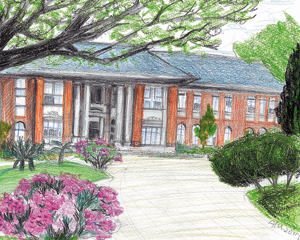
二月的行政大樓
Administration Building in February
二月の行政棟
|
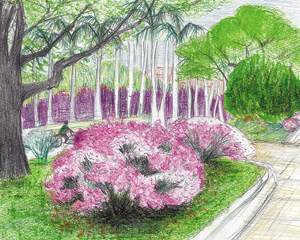
三月的杜鵑花
Azaleas in March
三月のツツジ
|
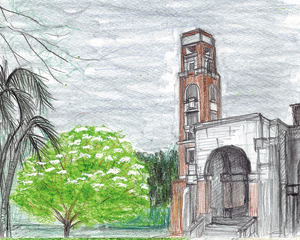
四月的流蘇
White fringe tree in April
四月のヒトツバタゴ |
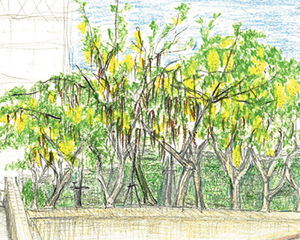
五月的阿勃勒
Golden shower trees in May
五月のカッシア瘻(ろう) |
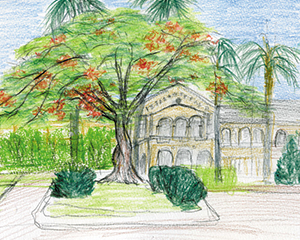
六月的鳳凰花
Flamboyant tree in June
六月の鳳凰木(ホウオウボク) |
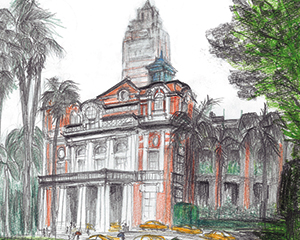
七月的臺大醫院
NTU hospital in July
七月の台大病院 |
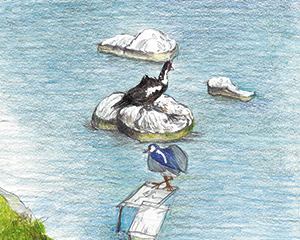
八月的生態池
Ecological pond in August
八月の生態池 |
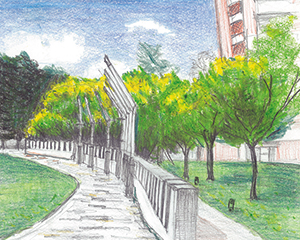
九月的臺灣欒樹
Taiwanese rain trees in September
九月の台湾モクゲンジ |
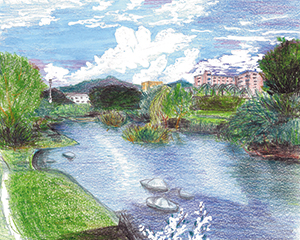
十月的生態池
Ecological pond in October
十月の生態池 |
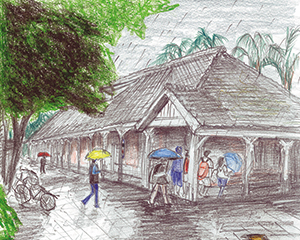
十一月小小福附近的老教室
Aged classrooms next to Xiao Xiao Fu Commissary in November
十一月の小小福付近の古い教室 |
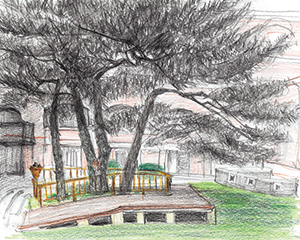
十二月的共同三松
Three Okinawa pines in front of Common Subjects Classroom in December
十二月の共同の三松 |
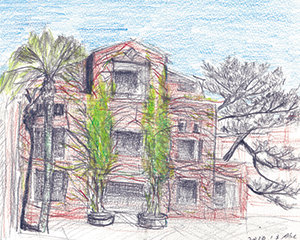
一月共同教室的常春藤
Ivy over Common Subjects Classroom Building in January
一月の共同教室棟のツタ |
| |
|
| |
|
| |
|
| |
|
| |
|
| |
|
|

